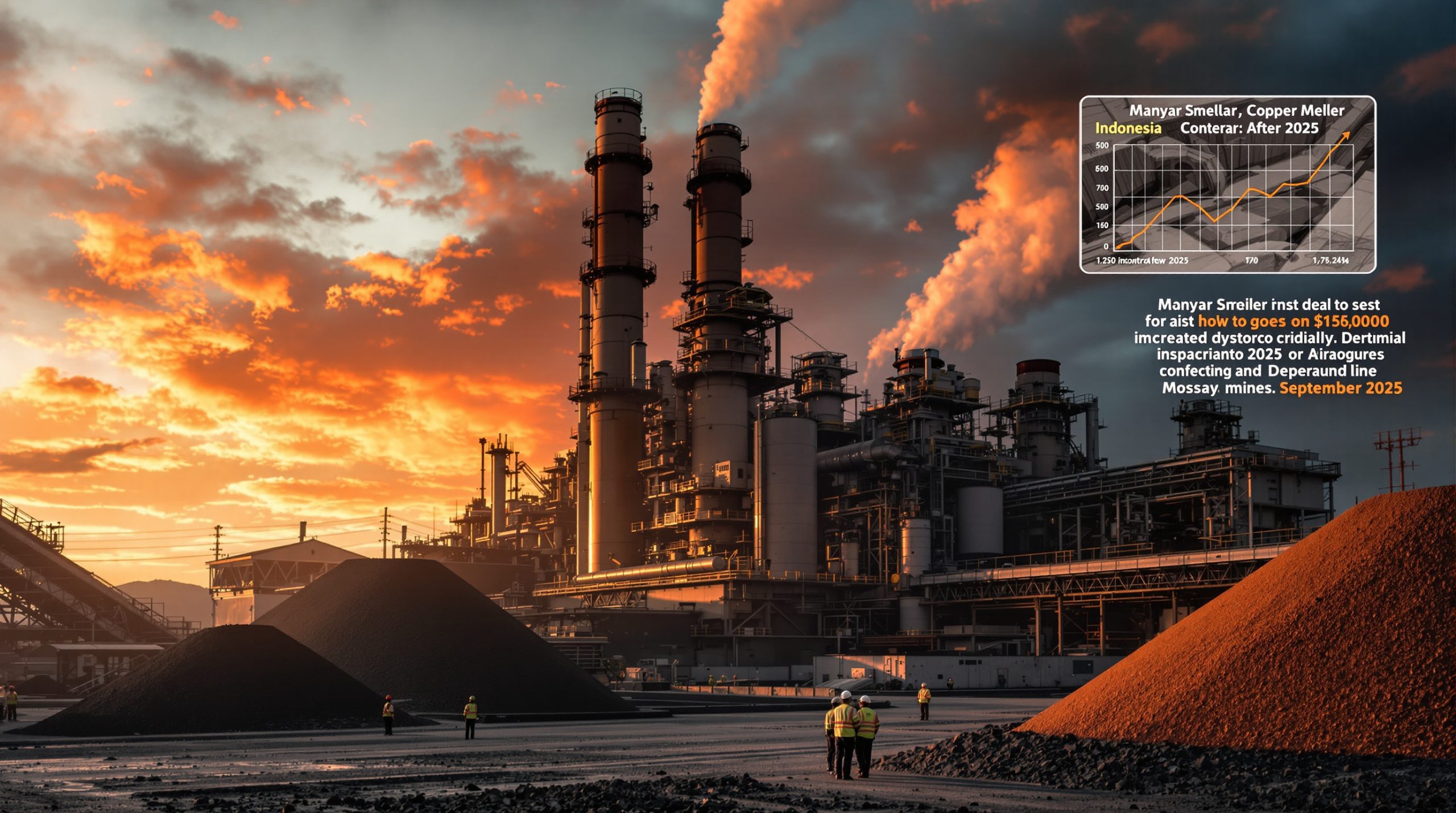The Copper Conundrum: Why the Anglo-Teck Merger Won't Solve the Global Shortage
The world is racing toward a severe copper shortage that threatens to derail the green energy transition and broader electrification efforts. As mining giants scramble for solutions, the recent $54 billion Anglo-Teck merger has captured headlines as a potential answer to supply constraints. However, industry analysis suggests this high-profile deal represents an exception rather than a viable model for addressing the fundamental Anglo-Teck merger copper shortage facing global markets.
What's Driving the Global Copper Supply Deficit?
The mismatch between copper production and projected demand represents one of the most significant challenges facing the global mining sector and clean energy transition. Current production volumes simply cannot keep pace with accelerating demand driven by electrification initiatives worldwide.
Global copper production reached approximately 23 million metric tons in 2024, according to the International Energy Agency's Global Critical Minerals Outlook. While announced projects could potentially increase output to 24 million tons by the late 2020s, production could subsequently decline to below 20 million tons by 2035 without substantial new supply additions.
Meanwhile, copper demand is projected to approach 33 million metric tons annually by 2035, creating a potential supply gap of 9-13 million tons. This looming deficit exists despite copper price predictions already trading around $10,500 per ton, representing a 40% increase from three years prior.
The production growth outlook remains bleak in the near term. According to Citigroup analysts, global copper output growth is expected to be negligible in 2025 and reach only 1.3% in 2026 – far below the 25-year historical average of over 2.5% annual growth.
The Scale of the Supply-Demand Imbalance
Several factors contribute to the widening gap between copper supply and demand:
-
Accelerating electrification: Electric vehicles require 2-4 times more copper than conventional vehicles
-
Renewable energy infrastructure: Wind and solar installations are copper-intensive technologies
-
Power grid modernization: Updating aging electrical infrastructure necessitates significant copper inputs
-
Limited recycling capacity: While recycling rates are improving, secondary sources cannot fill the projected gap
-
Declining discovery rates: Exploration success has diminished dramatically, with only 14 copper deposits discovered between 2013-2023, compared to 225 in the previous two decades
Can Corporate Consolidation Solve the Copper Crisis?
The Anglo-Teck merger represents the largest mining deal in decades, creating a copper powerhouse with significant production capacity and expansion potential. However, rather than signaling a wave of similar consolidations that could address supply constraints, market analysts view the deal as having unique characteristics unlikely to be replicated elsewhere.
The $54 billion merger combines Anglo American with Teck Resources in a nil-premium structure – meaning Anglo American did not pay an acquisition premium above Teck's market valuation. This created favorable economics that might not exist in other potential combinations.
At the time of the merger, Teck mined over 500,000 tons of copper annually. Based on Teck's $17 billion valuation (including net debt), the effective acquisition cost worked out to approximately $30,000 per ton of existing production capacity. While high, this avoided the extended development timelines and risks associated with greenfield projects.
Anglo-Teck: A Strategic Exception Rather Than the Rule
The merger's unique advantages include:
-
Geographic synergies: The companies hold stakes in Chilean mining operations located unusually close together, enabling operational efficiencies rarely available in mining M&A
-
Market timing: Teck's share price had fallen 25% in the year before the deal due to production challenges in Chile, creating favorable acquisition economics
-
Brownfield expansion potential: The combined entity plans to add 175,000 tons of annual copper production by 2030 at a cost of $1.9 billion (approximately $11,000 per ton) – significantly below industry averages for new capacity
-
Combined expertise: Pooled technical knowledge and operational experience in similar geological settings
-
Portfolio optimization: Ability to prioritize highest-return assets across the combined portfolio
According to Wood Mackenzie analysis, however, the merged entity "could even see less overall output than if the companies had remained separate, because it can now cherry-pick the highest-return mines" – highlighting that consolidation doesn't automatically translate to production growth.
Why Are New Copper Projects So Difficult to Develop?
The economics of new copper mine development have become increasingly challenging, creating significant barriers to expanding global supply through traditional means. Multiple factors contribute to this difficulty, ranging from financial hurdles to logistical constraints.
Capital costs for new copper production have soared in recent years. According to the International Energy Agency, capital expenditure requirements in Latin America – the world's primary copper-producing region – have increased by 65% since 2020. This applies to both greenfield (entirely new) and brownfield (expansion) projects.
Cost estimates vary significantly among major mining companies. BHP places average development costs at approximately $23,000 per ton of annual production capacity across all project types. However, recent specific projects suggest even higher figures – Teck's Quebrada Blanca operation in Chile cost $29,000 per ton, while Antofagasta's Centinela project reached $30,000 per ton.
The Economics of Copper Mine Development
These escalating costs create formidable challenges:
-
Massive capital requirements: A new 200,000-ton-per-year copper mine at the upper end of the cost range would require approximately $6 billion in upfront capital
-
Extended payback periods: Investors must wait years or even decades for return on investment
-
Price uncertainty: Long-term copper price forecasts must justify the substantial upfront expenditure
-
Financing challenges: Securing funding for multi-billion-dollar projects in cyclical commodity markets
-
Required copper prices: According to mining investment analysts, new major projects typically require copper prices exceeding $12,000 per ton to generate acceptable returns – well above current market levels
Beyond the financial challenges, new copper projects face significant timeline and regulatory obstacles. The average development timeline from initial discovery to production now stretches to approximately 17 years, according to industry analysis. This extended period reflects increasingly complex permitting requirements, environmental reviews, community consultations, and technical challenges associated with lower-grade deposits in more remote locations.
How Are Current Production Challenges Worsening the Shortage?
Recent operational disruptions at major copper mines have highlighted the fragility of global copper supply forecast and exacerbated near-term shortages. These events underscore the concentrated nature of copper production and the impact even temporary disruptions can have on global markets.
Freeport-McMoRan, one of the world's largest copper producers, recently experienced a significant setback when its massive Grasberg mine in Indonesia halted production following worker fatalities. The incident caused Freeport's shares to plummet more than 15% in a single day, reflecting the market's assessment of the disruption's significance.
Additional supply issues have affected operations in Panama and the Democratic Republic of Congo, further constraining global output. These disruptions occur against a backdrop of limited exploration success and declining investment in future supply.
Major Supply Chain Disruptions
The industry's fragility stems from several factors:
-
Concentrated production: A relatively small number of mines account for a disproportionate share of global copper output
-
Complex operations: Modern copper mines involve sophisticated processing systems vulnerable to technical failures
-
Aging infrastructure: Many major operations utilize equipment and facilities approaching the end of their design life
-
Declining ore grades: Lower copper content per ton of processed material increases operational complexity
-
Resource nationalism: Growing government intervention in major copper-producing regions creates regulatory uncertainty
The exploration picture provides little comfort for future supply. Of 239 copper deposits discovered between 1990 and 2023, only 14 occurred in the final decade of that period, according to the International Energy Agency. This dramatic decline in discovery success coincides with reduced exploration budgets, which fell from over 6% of copper EBITDA in the early 2010s to below 3% in 2024, based on Bernstein analyst estimates.
What Makes the Anglo-Teck Merger Unique?
The Anglo-Teck deal represents a strategic opportunity that differs significantly from typical mining mergers, offering efficiencies that would be difficult to replicate elsewhere in the industry. The combination's distinctive characteristics help explain why analysts view it as an exception rather than a model for broader industry consolidation.
Perhaps most significantly, the merger's nil-premium structure meant Anglo American avoided paying the typical 20-40% acquisition premium above market value that characterizes most mining takeovers. This approach became viable partly due to Teck's share price having declined 25% in the year before the deal, attributed to production challenges at its Chilean operations.
The geographic proximity of the companies' assets represents another crucial advantage rarely found in potential mining combinations. Anglo American and Teck hold significant stakes in Chilean copper operations located unusually close to each other, creating opportunities for shared infrastructure, integrated logistics, and operational knowledge transfer.
Strategic Advantages of the Anglo-Teck Combination
The merger's unique characteristics include:
-
Expansion economics: The combined entity projects adding 175,000 tons of annual copper production by 2030 at approximately $11,000 per ton – far below the $23,000-$30,000 per ton typical for new capacity
-
Immediate production: Unlike greenfield projects requiring years of development, the merger provided immediate access to Teck's 500,000+ tons of annual copper production
-
Jurisdictional advantages: Operations primarily in stable mining jurisdictions with established regulatory frameworks
-
Portfolio diversification: Combined assets across multiple geographies reduce country-specific risks
-
Technical synergies: Pooled expertise in similar geological settings enhances operational efficiency
Without these specific circumstances, other potential mining mergers would likely face less favorable economics and greater integration challenges. This helps explain why the Anglo-Teck combination stands as an exception rather than the beginning of an industry-wide consolidation trend.
Why Aren't Other Mining Companies Following Suit?
Despite the apparent benefits of the Anglo-Teck merger, several factors limit the potential for similar deals to address the copper supply deficit. Historical experiences with unsuccessful mergers, shareholder preferences, and structural industry challenges all contribute to hesitancy around major consolidation initiatives.
Mining companies carry the institutional memory of previous M&A failures. Rio Tinto's 2007 acquisition of aluminum producer Alcan – frequently cited as a cautionary tale – left lasting financial and reputational damage. Such experiences create natural conservatism among mining executives when evaluating potential combinations.
Modern shareholder expectations also complicate consolidation efforts. Many mining investors prefer predictable returns through dividends and share buybacks rather than transformative acquisitions with uncertain outcomes. This preference reflects the cyclical nature of commodity markets and disappointing returns from previous industry consolidation waves.
Barriers to Industry Consolidation
Several specific obstacles impede broader mining consolidation:
-
Limited geographic overlap: Few major mining companies have operations in close proximity that would generate the synergies seen in the Anglo-Teck combination
-
Premium expectations: Most acquisition targets and their shareholders expect significant takeover premiums, undermining transaction economics
-
Regulatory scrutiny: Antitrust and foreign investment reviews have become increasingly rigorous for major mining combinations
-
Cultural integration challenges: Mining companies often have distinct operational approaches and corporate cultures that complicate post-merger integration
-
Alternative growth strategies: Many producers view brownfield expansions and incremental improvements as lower-risk paths to growth
Industry analysts note that even successful consolidation might not significantly increase overall copper production. As Wood Mackenzie observed regarding Anglo-Teck, merged entities can "cherry-pick the highest-return mines" rather than maximizing output – potentially resulting in rationalized production focused on margin rather than volume.
How Will the Supply Shortage Impact Copper Prices?
The combination of limited new supply, operational disruptions, and growing demand points to significant price increases in the coming years. Recent production setbacks have already prompted analysts to raise their copper price forecasts substantially.
Following industry-wide production challenges, Bank of America analysts revised their copper price projections upward to $11,313 per ton for 2026 and $13,500 per ton for 2027. These forecasts represent significant increases from current levels around $10,500 per ton and reflect growing recognition of structural supply constraints.
Economic theory suggests such price signals should eventually stimulate increased production. However, the industry's extended development timelines mean that even if higher prices trigger investment decisions today, the resulting supply wouldn't reach markets for many years – potentially sustaining elevated prices through the remainder of this decade.
Price Forecasts and Market Implications
Key price drivers and implications include:
-
Electric vehicle growth: Each EV requires 2-4 times more copper than conventional vehicles, creating exponential demand growth as adoption accelerates
-
Renewable energy expansion: Wind and solar installations are highly copper-intensive, with demand increasing as climate targets drive renewable deployment
-
Grid infrastructure investment: Aging power grids worldwide require upgrading to handle distributed energy resources and increasing electricity demand
-
Industrial automation: Robotics and automated systems require substantial copper inputs for motors, controls, and connectivity
-
Urbanization trends: Continued urban growth in developing regions drives copper demand for construction and infrastructure
While recycling rates continue improving, secondary copper sources cannot fully offset the projected supply deficit. The International Energy Agency notes that even with projected increases in recycled material, primary copper production remains essential to meeting future demand.
What Are the Consequences of the Copper Shortage Beyond Mining?
The copper deficit will have far-reaching implications across multiple industries and the broader global economy. As a critical input for electrification technologies, copper constraints could potentially slow the pace of the green energy transition and increase its costs.
Electric vehicle manufacturers face particularly significant exposure to copper price volatility. With EVs requiring significantly more copper than conventional vehicles, sustained high prices could impact vehicle affordability and potentially slow adoption rates. This creates tension between climate policy objectives and economic realities.
Renewable energy developers will similarly feel the impact of copper constraints. Solar and wind installations utilize substantial copper quantities for wiring, transformers, and other components. Higher material costs could alter project economics and potentially slow deployment timelines.
Downstream Economic Impacts
The ripple effects extend well beyond direct users:
-
Grid modernization challenges: Utilities may face higher costs and extended timelines for critical infrastructure upgrades
-
Consumer electronics pricing: Devices ranging from smartphones to home appliances incorporate copper components
-
Construction cost increases: Residential and commercial buildings require substantial copper for electrical systems
-
Manufacturing competitiveness: Regions with secured copper supply may gain advantages over areas facing shortages
-
Substitution pressures: High copper prices will accelerate research into alternative materials and technologies
The geographic distribution of impacts will vary significantly. Copper-producing nations like Chile, Peru, and the Democratic Republic of Congo stand to benefit from higher prices, though this may be partially offset by increasing resource nationalism as governments seek greater economic participation in mining operations.
Major copper-consuming economies – particularly China, which accounts for over half of global copper demand – face potential manufacturing and infrastructure constraints if supply cannot keep pace with requirements. This creates strategic incentives for securing long-term supply through overseas investments and supply chain partnerships.
Why Aren't Price Signals Triggering More Supply?
Traditional economic theory suggests that higher prices should stimulate increased production, but several factors are preventing this market response in the copper industry. The disconnect between price signals and supply growth reflects structural barriers rather than market inefficiency.
Perhaps the most significant impediment is the sheer capital intensity of copper mine development. With major projects requiring $6 billion or more in upfront investment before generating any revenue, financing constraints limit the number of companies capable of developing new mines independently. Even for major producers, such investments represent significant capital allocation decisions that compete with shareholder return initiatives.
The extended timeline from discovery to production – now averaging 17 years – further complicates investment decisions. Mining companies must make projections about copper prices nearly two decades into the future when evaluating potential projects, creating substantial forecast risk that often leads to conservative decision-making.
Structural Barriers to Supply Response
Multiple factors impede the market's ability to respond to price signals:
-
Declining ore grades: New discoveries typically feature lower copper content than historical mines, requiring more complex processing
-
Water constraints: Many prospective mining regions face severe water scarcity, limiting processing options
-
Social license challenges: Community opposition to mining development has intensified, creating permitting obstacles
-
Technical complexity: Remaining copper resources often present metallurgical challenges requiring specialized processing methods
-
Political uncertainty: Resource nationalism and regulatory volatility complicate long-term investment planning in key copper regions
-
Environmental requirements: Stricter environmental standards increase both capital and operating costs for new developments
These barriers help explain the paradox of high copper prices coexisting with limited investment in new supply. Until prices rise substantially above current levels – potentially exceeding $12,000 per ton on a sustained basis – many potential projects will remain economically marginal despite growing demand.
What Solutions Could Address the Copper Supply Gap?
While the Anglo-Teck merger represents one approach to the copper shortage, a broader range of strategies will be needed to address the supply deficit. No single solution can fully resolve the projected 9-13 million ton annual gap between anticipated supply and demand by 2035.
Brownfield expansions at existing operations represent the lowest-hanging fruit for increasing copper output. These projects typically require significantly less capital per ton of new capacity – as demonstrated by Anglo-Teck's planned 175,000-ton addition at approximately $11,000 per ton. Regulatory approvals also generally come more quickly for expansions than for entirely new developments.
Technological innovations offer another promising pathway. Advanced processing methods that improve recovery rates from existing operations, enable economic extraction from lower-grade ores, or reduce energy and water requirements could significantly enhance resource utilization. Similarly, exploration technologies that improve discovery rates could replenish the development pipeline.
Potential Pathways to Increased Copper Supply
Multiple strategies must be pursued simultaneously:
-
Recycling enhancement: Improved collection systems and processing technologies for end-of-life products
-
Substitution initiatives: Development of aluminum-based alternatives for certain applications where technically feasible
-
Process efficiency improvements: Technologies that reduce processing losses and improve recovery rates
-
Mining waste reprocessing: Extracting copper from historical tailings using new technologies
-
Policy reforms: Streamlined permitting processes that maintain environmental standards while reducing timeline uncertainty
-
Exploration incentives: Tax benefits or co-funding arrangements to stimulate private sector exploration investment
-
Public-private partnerships: Government participation in strategic projects to enhance development economics
Ultimately, higher copper prices will likely be required to unlock substantial new supply. Bank of America's forecasts of $11,313 per ton in 2026 and $13,500 per ton in 2027 would approach the threshold many analysts believe necessary to stimulate significant new project development.
FAQ: Understanding the Copper Market Dynamics
How significant is the Anglo-Teck merger in the global copper market?
The Anglo-Teck merger creates one of the world's largest copper producers, with combined production exceeding 875,000 tonnes initially. While substantial, this represents less than 4% of global copper production. The deal's significance lies more in demonstrating the challenging economics of copper supply expansion than in materially changing the market's supply-demand balance.
The merger's planned expansion to add 175,000 tonnes by 2030 at approximately $11,000 per ton highlights the advantage of brownfield development over greenfield projects. However, even this growth – representing less than 1% of global production – cannot significantly offset the projected multi-million-ton deficit.
Why can't mining companies simply increase production when prices rise?
Copper mine development faces numerous challenges beyond price considerations. The 17-year average timeline from discovery to production means that even if investment decisions were made immediately in response to today's prices, the resulting production wouldn't reach markets until the 2040s.
Capital intensity creates another major barrier. At $23,000-$30,000 per ton of annual capacity, a mid-sized copper mine requires billions in upfront investment before generating any return. This capital requirement limits the pool of companies capable of independently developing major projects and creates significant financial risk given copper price volatility.
Technical and regulatory challenges further complicate development. Many remaining copper resources feature lower grades, complex mineralogy, or remote locations that increase technical difficulty. Meanwhile, permitting processes have grown lengthier and more complex, adding years to development timelines and creating project uncertainty.
How will the copper shortage affect the green energy transition?
The copper deficit could significantly impact the pace and cost of electrification efforts. Electric vehicles require 2-4 times more copper than conventional vehicles, while renewable energy infrastructure is highly copper-intensive. Higher copper prices and potential supply constraints may slow deployment and increase costs across these sectors.
Grid modernization particularly depends on copper availability. As power systems evolve to accommodate distributed generation, energy storage, and increased electrification, substantial copper inputs are required for transformers, wiring, and other components. Supply constraints could delay critical infrastructure improvements.
Manufacturers may increasingly explore substitution strategies where technically feasible. Aluminum can replace copper in certain applications, though it generally offers lower performance. More exotic alternatives like graphene show promise for specific uses but remain far from commercial scale for most applications.
What role does recycling play in addressing the copper shortage?
Copper recycling rates already exceed most other materials, with approximately 35% of global copper consumption coming from secondary sources. However, significant expansion potential remains, particularly in developing regions with less established collection systems.
The "urban mine" of copper in existing buildings, infrastructure, and products represents a substantial resource. Improved collection, sorting, and processing technologies could increase recovery rates and quality. However, the International Energy Agency's analysis indicates recycling alone cannot fill the projected supply gap given growing overall demand.
The circular economy concept is particularly relevant for copper, as the metal can be recycled indefinitely without loss of performance. Enhanced product design for recyclability, improved collection infrastructure, and innovative processing technologies all contribute to maximizing secondary supply.
Will technological innovations help solve the copper shortage?
Technological advancements offer multiple pathways to address the copper deficit. In mining, mining innovation trends in processing technology can improve recovery rates from existing operations and enable economic extraction from lower-grade resources previously considered unviable. Exploration technologies utilizing artificial intelligence and advanced sensing capabilities may improve discovery rates.
Material science advances could develop viable substitutes for certain copper applications, reducing demand pressure. While perfect replacements remain unlikely for many high-performance applications, partial substitution across multiple use cases could significantly impact overall demand.
Process innovations in manufacturing may reduce the copper intensity of certain products without compromising performance. Techniques like additive manufacturing, advanced alloy development, and precision engineering can optimize copper utilization while maintaining or improving functionality.
With growing demand and limited new supply, the copper investment outlook remains compelling despite potential volatility. Investors must carefully consider both the structural factors supporting higher prices and the project-specific risks inherent in mining development when evaluating opportunities in this critical metal.
Ready to Capitalise on the Next Major Mineral Discovery?
Stay ahead of the market with Discovery Alert's proprietary Discovery IQ model, which instantly identifies significant mineral discoveries on the ASX, including emerging copper opportunities. Explore why major discoveries can generate substantial returns by visiting the Discovery Alert discoveries page and gain immediate market insights with your 30-day free trial.




